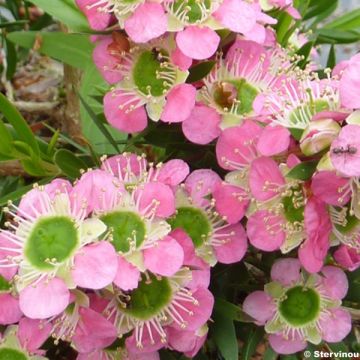

Washingtonia robusta - Mexican Fan Palm
Washingtonia robusta - Mexican Fan Palm
Washingtonia robusta
Mexican Fan Palm, Skyduster
The species giving me satisfaction has withstood this unusually cold winter. Two or three palmate leaves are damaged.
JEAN LUC, 09/04/2018
Special offer!
Receive a €20 voucher for any order over €90 (excluding delivery costs, credit notes, and plastic-free options)!
1- Add your favorite plants to your cart.
2- Once you have reached €90, confirm your order (you can even choose the delivery date!).
3- As soon as your order is shipped, you will receive an email containing your voucher code, valid for 3 months (90 days).
Your voucher is unique and can only be used once, for any order with a minimum value of €20, excluding delivery costs.
Can be combined with other current offers, non-divisible and non-refundable.
Home or relay delivery (depending on size and destination)
Schedule delivery date,
and select date in basket
This plant carries a 24 months recovery warranty
More information
We guarantee the quality of our plants for a full growing cycle, and will replace at our expense any plant that fails to recover under normal climatic and planting conditions.

Would this plant suit my garden?
Set up your Plantfit profile →
Description
The Washingtonia robusta is a tall palm tree with a very slender habit, native to Northwestern Mexico. It is distinguished by its very fast growth. Its trunk, thin and slender, is topped by a crown of large palmate leaves, fan-shaped, almost round. It is also recognized by the 'skirt' of dead and grey leaves that surround the top of the trunk. Not very hardy, it is best suited to mild climates. It tolerates sea spray and withstands summer drought.
The Washingtonia robusta belongs to the family of Arecaceae, it is a botanical species closely related to the Washingtonia filifera, with a slightly shorter habit and a more sturdy trunk. It originates from Sonora, a desert region covering Northern Mexico and Baja California, where it grows naturally in arid places and at the bottom of canyons, where water is available at depth. This palm tree, which can reach a height of 25m (82ft), has a trunk with a diameter of 80cm (31.5in). Its foliage, arranged in a terminal crown, will not exceed 3m (9.8ft) in width. The trunk, widened at the base, seems endless. It branches at the top, in the form of reddish-based petioles, with spiky teeth, in a brown-orange colour. Each petiole bears a large circular leaf, 80cm (31.5in) in diameter, shiny green, with narrow segmented edges. On specimens that have reached a certain size, the leaves have a visible light spot where the segments and the petiole meet, when viewed from below. The 'skirt' apparent at the top of the trunk is formed by withered and hanging petioles that persist for a long time on the plant. The spectacular flowering occurs outdoors in summer, in the form of long, arched inflorescences (up to 4m (157.4 ft)) that extend more than one metre beyond the crown. The flowers are numerous, cream to flesh-coloured, followed by countless small round fruits, black and shiny, each containing a smooth and shiny dark brown seed.
Highly appreciated as a coastal and mild climate street tree, the Washingtonia robusta is one of the most commonly cultivated ornamental palm species, along with the Washingtonia filifera and the Phoenix canariensis, from the Tropics to temperate countries. Irreplaceable and prominent in mild climates, it can also be cultivated elsewhere in a large container if stored indoors in a cool, bright and well-ventilated area during winter. Planted near an entrance, on either side of a gate, or as a standalone plant near a pool, it will be magnificent. Like Eucalyptus and tall Mimosa trees, in the background of a flowerbed, it forms a typical backdrop for gardens along the Mediterranean or the Atlantic coast in the south of France.
Report an error about the product description
Washingtonia robusta - Mexican Fan Palm in pictures


Plant habit
Flowering
Foliage
Botanical data
Washingtonia
robusta
Arecaceae
Mexican Fan Palm, Skyduster
North America
Planting and care
This palm tree shows a very rapid growth. Plant Washingtonia robusta in open ground in mild climates, or in a very large pot in other regions. Plant in well-worked, well-drained soil, even poor and dry on the surface. It is not fussy about the nature of the soil, but does show a preference for alkaline soils, like many palms originating from arid areas. It withstands drought well once established. It is best to plant it in a balanced mixture of potting soil and garden soil, in a sunny location and protected from cold and dry winds. Water regularly during the first 3 years, especially if the summer is dry. Easy to grow, it requires little maintenance except for pruning the oldest fronds close to the stem.
In the PACA region, where they are often planted, as well as throughout southern France and Spain, Washingtonia palms are victims of parasites such as the feared and widely spread Paysandra archon worm, a large butterfly that wreaks havoc even in England. Specific treatments are now available as a preventive measure.
Planting period
Intended location
Care
-
, onOrder confirmed
Reply from on Promesse de fleurs
Similar products
Haven't found what you were looking for?
Hardiness is the lowest winter temperature a plant can endure without suffering serious damage or even dying. However, hardiness is affected by location (a sheltered area, such as a patio), protection (winter cover) and soil type (hardiness is improved by well-drained soil).

Photo Sharing Terms & Conditions
In order to encourage gardeners to interact and share their experiences, Promesse de fleurs offers various media enabling content to be uploaded onto its Site - in particular via the ‘Photo sharing’ module.
The User agrees to refrain from:
- Posting any content that is illegal, prejudicial, insulting, racist, inciteful to hatred, revisionist, contrary to public decency, that infringes on privacy or on the privacy rights of third parties, in particular the publicity rights of persons and goods, intellectual property rights, or the right to privacy.
- Submitting content on behalf of a third party;
- Impersonate the identity of a third party and/or publish any personal information about a third party;
In general, the User undertakes to refrain from any unethical behaviour.
All Content (in particular text, comments, files, images, photos, videos, creative works, etc.), which may be subject to property or intellectual property rights, image or other private rights, shall remain the property of the User, subject to the limited rights granted by the terms of the licence granted by Promesse de fleurs as stated below. Users are at liberty to publish or not to publish such Content on the Site, notably via the ‘Photo Sharing’ facility, and accept that this Content shall be made public and freely accessible, notably on the Internet.
Users further acknowledge, undertake to have ,and guarantee that they hold all necessary rights and permissions to publish such material on the Site, in particular with regard to the legislation in force pertaining to any privacy, property, intellectual property, image, or contractual rights, or rights of any other nature. By publishing such Content on the Site, Users acknowledge accepting full liability as publishers of the Content within the meaning of the law, and grant Promesse de fleurs, free of charge, an inclusive, worldwide licence for the said Content for the entire duration of its publication, including all reproduction, representation, up/downloading, displaying, performing, transmission, and storage rights.
Users also grant permission for their name to be linked to the Content and accept that this link may not always be made available.
By engaging in posting material, Users consent to their Content becoming automatically accessible on the Internet, in particular on other sites and/or blogs and/or web pages of the Promesse de fleurs site, including in particular social pages and the Promesse de fleurs catalogue.
Users may secure the removal of entrusted content free of charge by issuing a simple request via our contact form.
The flowering period indicated on our website applies to countries and regions located in USDA zone 8 (France, the United Kingdom, Ireland, the Netherlands, etc.)
It will vary according to where you live:
- In zones 9 to 10 (Italy, Spain, Greece, etc.), flowering will occur about 2 to 4 weeks earlier.
- In zones 6 to 7 (Germany, Poland, Slovenia, and lower mountainous regions), flowering will be delayed by 2 to 3 weeks.
- In zone 5 (Central Europe, Scandinavia), blooming will be delayed by 3 to 5 weeks.
In temperate climates, pruning of spring-flowering shrubs (forsythia, spireas, etc.) should be done just after flowering.
Pruning of summer-flowering shrubs (Indian Lilac, Perovskia, etc.) can be done in winter or spring.
In cold regions as well as with frost-sensitive plants, avoid pruning too early when severe frosts may still occur.
The planting period indicated on our website applies to countries and regions located in USDA zone 8 (France, United Kingdom, Ireland, Netherlands).
It will vary according to where you live:
- In Mediterranean zones (Marseille, Madrid, Milan, etc.), autumn and winter are the best planting periods.
- In continental zones (Strasbourg, Munich, Vienna, etc.), delay planting by 2 to 3 weeks in spring and bring it forward by 2 to 4 weeks in autumn.
- In mountainous regions (the Alps, Pyrenees, Carpathians, etc.), it is best to plant in late spring (May-June) or late summer (August-September).
The harvesting period indicated on our website applies to countries and regions in USDA zone 8 (France, England, Ireland, the Netherlands).
In colder areas (Scandinavia, Poland, Austria...) fruit and vegetable harvests are likely to be delayed by 3-4 weeks.
In warmer areas (Italy, Spain, Greece, etc.), harvesting will probably take place earlier, depending on weather conditions.
The sowing periods indicated on our website apply to countries and regions within USDA Zone 8 (France, UK, Ireland, Netherlands).
In colder areas (Scandinavia, Poland, Austria...), delay any outdoor sowing by 3-4 weeks, or sow under glass.
In warmer climes (Italy, Spain, Greece, etc.), bring outdoor sowing forward by a few weeks.








































